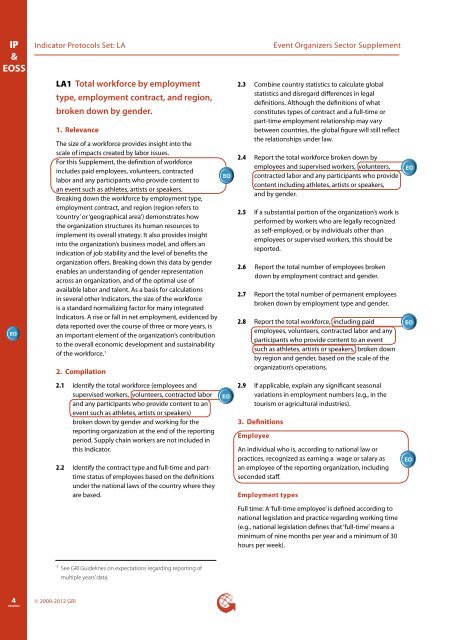Event Organizers Sector Supplement - Global Reporting Initiative
Event Organizers Sector Supplement - Global Reporting Initiative
Event Organizers Sector Supplement - Global Reporting Initiative
You also want an ePaper? Increase the reach of your titles
YUMPU automatically turns print PDFs into web optimized ePapers that Google loves.
IP<br />
&<br />
EOSS<br />
Indicator Protocols Set: LA<br />
<strong>Event</strong> <strong>Organizers</strong> <strong>Sector</strong> <strong>Supplement</strong><br />
EO<br />
LA1 Total workforce by employment<br />
type, employment contract, and region,<br />
broken down by gender.<br />
1. Relevance<br />
The size of a workforce provides insight into the<br />
scale of impacts created by labor issues.<br />
For this <strong>Supplement</strong>, the definition of workforce<br />
includes paid employees, volunteers, contracted<br />
labor and any participants who provide content to<br />
an event such as athletes, artists or speakers.<br />
Breaking down the workforce by employment type,<br />
employment contract, and region (region refers to<br />
‘country’ or ‘geographical area’) demonstrates how<br />
the organization structures its human resources to<br />
implement its overall strategy. It also provides insight<br />
into the organization’s business model, and offers an<br />
indication of job stability and the level of benefits the<br />
organization offers. Breaking down this data by gender<br />
enables an understanding of gender representation<br />
across an organization, and of the optimal use of<br />
available labor and talent. As a basis for calculations<br />
in several other Indicators, the size of the workforce<br />
is a standard normalizing factor for many integrated<br />
Indicators. A rise or fall in net employment, evidenced by<br />
data reported over the course of three or more years, is<br />
an important element of the organization’s contribution<br />
to the overall economic development and sustainability<br />
of the workforce. 1<br />
2. Compilation<br />
EO<br />
2.3 Combine country statistics to calculate global<br />
statistics and disregard differences in legal<br />
definitions. Although the definitions of what<br />
constitutes types of contract and a full-time or<br />
part-time employment relationship may vary<br />
between countries, the global figure will still reflect<br />
the relationships under law.<br />
2.4 Report the total workforce broken down by<br />
employees and supervised workers, volunteers,<br />
contracted labor and any participants who provide<br />
content including athletes, artists or speakers,<br />
and by gender.<br />
2.5 If a substantial portion of the organization’s work is<br />
performed by workers who are legally recognized<br />
as self-employed, or by individuals other than<br />
employees or supervised workers, this should be<br />
reported.<br />
2.6 Report the total number of employees broken<br />
down by employment contract and gender.<br />
2.7 Report the total number of permanent employees<br />
broken down by employment type and gender.<br />
2.8 Report the total workforce, including paid<br />
employees, volunteers, contracted labor and any<br />
participants who provide content to an event<br />
such as athletes, artists or speakers, broken down<br />
by region and gender, based on the scale of the<br />
organization’s operations.<br />
EO<br />
EO<br />
2.1 Identify the total workforce (employees and<br />
supervised workers, volunteers, contracted labor<br />
and any participants who provide content to an<br />
event such as athletes, artists or speakers)<br />
broken down by gender and working for the<br />
reporting organization at the end of the reporting<br />
period. Supply chain workers are not included in<br />
this Indicator.<br />
2.2 Identify the contract type and full-time and parttime<br />
status of employees based on the definitions<br />
under the national laws of the country where they<br />
are based.<br />
EO<br />
2.9 If applicable, explain any significant seasonal<br />
variations in employment numbers (e.g., in the<br />
tourism or agricultural industries).<br />
3. Definitions<br />
Employee<br />
An individual who is, according to national law or<br />
practices, recognized as earning a wage or salary as<br />
an employee of the reporting organization, including<br />
seconded staff.<br />
Employment types<br />
EO<br />
Full time: A ‘full-time employee’ is defined according to<br />
national legislation and practice regarding working time<br />
(e.g., national legislation defines that ‘full-time’ means a<br />
minimum of nine months per year and a minimum of 30<br />
hours per week).<br />
1<br />
See GRI Guidelines on expectations regarding reporting of<br />
multiple years’ data.<br />
4<br />
© 2000-2012 GRI

















